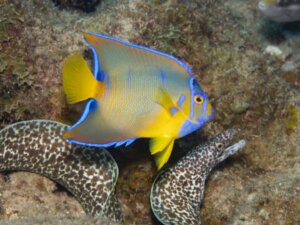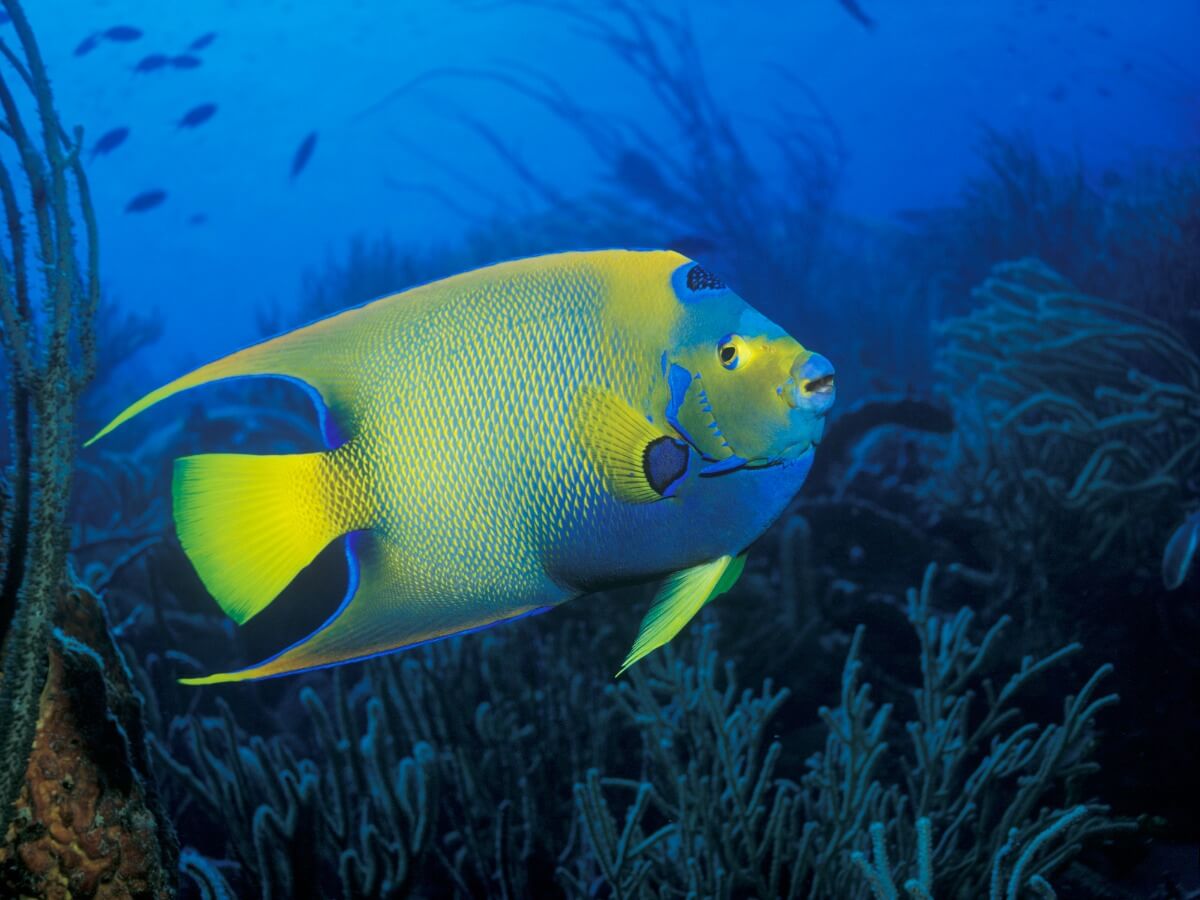Queen Angelfish: Habitat and Characteristics

The queen angelfish (Holacanthus ciliaris) is an actinopterygian fish found in the warmer reefs of the western Atlantic. It’s sometimes confused with the blue angelfish, but its appearance, although similar, shows certain clear differences.
In addition to keeping it in aquariums as an ornamental pet – due to its bright colors – its meat is consumed in some of the regions where it lives. If you want to get to know this fish of the Pomacanthidae family better, you can do so in the following lines.
Physical characteristics
As a good angelfish, Holacanthus ciliaris has a short, laterally compressed body, with a small mouth that features brush-shaped teeth. The dorsal and anal fins carry a long filament, very characteristic of this species. Females reach maturity at 22 centimeters long and males 24 centimeters (around 9 inches)
During the transition from juvenile to adult, spines form on the outside of the fish’s body, which increase in size as it takes its final shape.
The coloration in the juvenile stage is different from that of the adult. As they grow, these fish go from a shade of blue and yellows to totally yellow-orange with purple-blue edges. This is the color they remain with. If someone doesn’t know this, then it’s easy to confuse a juvenile with a fish of another species.
In addition, it should be noted that the queen angelfish can mate with the Holacanthus bermudensis or blue angelfish. The resulting hybrid shares traits of both species and is known as Townsend’s angelfish.

The behavior of the queen angelfish
This fish can be found alone, but it’s more common for the specimens to associate in pairs, which defend a territory among the corals. Occasionally, harems can be formed from a male with several females – 1 male and 4 or 5 females.
When observed alone, they’re usually young specimens, which frequent shallower waters. Once they mate or select an adult territory, they settle there and defend it. They aren’t migratory fish and in aquariums they’re considered extremely aggressive animals towards other species.
These fish are believed to communicate by transient color changes. However, little is known about their social systems.
Queen angelfish habitat
Queen angelfish inhabit reefs near Florida, the Bahamas, and the Gulf of Mexico. As they grow, the mature specimens go from inhabiting the shallow areas of the mangroves to settle in the depths of the corals. They support a considerable range of water salinity and their limit depth is 70 meters (230 feet) from the surface.
Queen angelfish feeding
This species mainly feeds on sponges. Tunicates, jellyfish, corals, plankton, and algae are also included in their diet. The young fish peck parasites from the skin of other fish, fulfilling the function of commensal cleaners.
Reproduction of the queen angelfish
Adults maintain their partners throughout the year. Fertilization occurs externally and males and females bring their cloaca closer together, after which they release clouds of sperm and eggs. The female can release 25,000 to 75,000 eggs each night and up to 10 million eggs during a spawning cycle.
After just 20 hours, the larvae hatch. They don’t have eyes, fins, nor even intestines, so they’ll feed on their yolk sac for about 48 hours without making any kind of movement.
The larvae won’t transform into juvenile fish until they’re 3-4 weeks old, although they then grow quite quickly. The queen angelfish doesn’t exhibit parental care, so the offspring are independent right from when they hatch.
Aquarium care
In captivity, these animals are difficult to keep and aren’t recommended for inexperienced aquarists. They require a large aquarium, as they’re very territorial fish and can harass other species that live with them – especially their same species. If their space is not respected, they will not hesitate to resort to physical violence.
In addition, these fish suffer a lot of stress during transport, which makes them prone to infections and poor adaptation to the aquarium and food.
Although it inhabits reefs, in captivity it isn’t recommended to keep queen angelfish in a coral aquarium: the adult specimens could cut them to create a refuge. Nor should they be installed in aquariums with sessile invertebrates, such as polyps or sponges, as they are part of their diet.
Feeding in captivity should be based on brine shrimp and mysis, supplemented with supplements such as fish, mussels and vegetables. To house a couple, a marine aquarium with a minimum capacity of 800 liters is required.
State of conservation
This species is in a state of least concern. Although its population remains stable, it isn’t free from threats. Among its greatest dangers are accidental fishing and the harvesting of resources in its habitat. When the coral reef degenerates, all the species that live in it are in danger, and the angelfish is no exception.

The queen angelfish fulfills a vital function in its ecosystem, like the rest of the species that live on the reefs. These aquatic environments keep a delicate balance and difficult to recover once it’s broken. If, despite what you’ve read here, you’d like to own one of these fish at home, it’s vitally important to be responsible and make sure that it hasn’t been taken from its natural environment.
The queen angelfish (Holacanthus ciliaris) is an actinopterygian fish found in the warmer reefs of the western Atlantic. It’s sometimes confused with the blue angelfish, but its appearance, although similar, shows certain clear differences.
In addition to keeping it in aquariums as an ornamental pet – due to its bright colors – its meat is consumed in some of the regions where it lives. If you want to get to know this fish of the Pomacanthidae family better, you can do so in the following lines.
Physical characteristics
As a good angelfish, Holacanthus ciliaris has a short, laterally compressed body, with a small mouth that features brush-shaped teeth. The dorsal and anal fins carry a long filament, very characteristic of this species. Females reach maturity at 22 centimeters long and males 24 centimeters (around 9 inches)
During the transition from juvenile to adult, spines form on the outside of the fish’s body, which increase in size as it takes its final shape.
The coloration in the juvenile stage is different from that of the adult. As they grow, these fish go from a shade of blue and yellows to totally yellow-orange with purple-blue edges. This is the color they remain with. If someone doesn’t know this, then it’s easy to confuse a juvenile with a fish of another species.
In addition, it should be noted that the queen angelfish can mate with the Holacanthus bermudensis or blue angelfish. The resulting hybrid shares traits of both species and is known as Townsend’s angelfish.

The behavior of the queen angelfish
This fish can be found alone, but it’s more common for the specimens to associate in pairs, which defend a territory among the corals. Occasionally, harems can be formed from a male with several females – 1 male and 4 or 5 females.
When observed alone, they’re usually young specimens, which frequent shallower waters. Once they mate or select an adult territory, they settle there and defend it. They aren’t migratory fish and in aquariums they’re considered extremely aggressive animals towards other species.
These fish are believed to communicate by transient color changes. However, little is known about their social systems.
Queen angelfish habitat
Queen angelfish inhabit reefs near Florida, the Bahamas, and the Gulf of Mexico. As they grow, the mature specimens go from inhabiting the shallow areas of the mangroves to settle in the depths of the corals. They support a considerable range of water salinity and their limit depth is 70 meters (230 feet) from the surface.
Queen angelfish feeding
This species mainly feeds on sponges. Tunicates, jellyfish, corals, plankton, and algae are also included in their diet. The young fish peck parasites from the skin of other fish, fulfilling the function of commensal cleaners.
Reproduction of the queen angelfish
Adults maintain their partners throughout the year. Fertilization occurs externally and males and females bring their cloaca closer together, after which they release clouds of sperm and eggs. The female can release 25,000 to 75,000 eggs each night and up to 10 million eggs during a spawning cycle.
After just 20 hours, the larvae hatch. They don’t have eyes, fins, nor even intestines, so they’ll feed on their yolk sac for about 48 hours without making any kind of movement.
The larvae won’t transform into juvenile fish until they’re 3-4 weeks old, although they then grow quite quickly. The queen angelfish doesn’t exhibit parental care, so the offspring are independent right from when they hatch.
Aquarium care
In captivity, these animals are difficult to keep and aren’t recommended for inexperienced aquarists. They require a large aquarium, as they’re very territorial fish and can harass other species that live with them – especially their same species. If their space is not respected, they will not hesitate to resort to physical violence.
In addition, these fish suffer a lot of stress during transport, which makes them prone to infections and poor adaptation to the aquarium and food.
Although it inhabits reefs, in captivity it isn’t recommended to keep queen angelfish in a coral aquarium: the adult specimens could cut them to create a refuge. Nor should they be installed in aquariums with sessile invertebrates, such as polyps or sponges, as they are part of their diet.
Feeding in captivity should be based on brine shrimp and mysis, supplemented with supplements such as fish, mussels and vegetables. To house a couple, a marine aquarium with a minimum capacity of 800 liters is required.
State of conservation
This species is in a state of least concern. Although its population remains stable, it isn’t free from threats. Among its greatest dangers are accidental fishing and the harvesting of resources in its habitat. When the coral reef degenerates, all the species that live in it are in danger, and the angelfish is no exception.

The queen angelfish fulfills a vital function in its ecosystem, like the rest of the species that live on the reefs. These aquatic environments keep a delicate balance and difficult to recover once it’s broken. If, despite what you’ve read here, you’d like to own one of these fish at home, it’s vitally important to be responsible and make sure that it hasn’t been taken from its natural environment.
All cited sources were thoroughly reviewed by our team to ensure their quality, reliability, currency, and validity. The bibliography of this article was considered reliable and of academic or scientific accuracy.
- Pyle, R., Myers, R., Rocha, L.A. & Craig, M.T. 2010. Holacanthus ciliaris. The IUCN Red List of Threatened Species 2010: e.T165883A6156566. https://dx.doi.org/10.2305/IUCN.UK.2010-4.RLTS.T165883A6156566.en. Downloaded on 28 June 2021.
- Ángel reina (intermedio). (2021). Banco de la República. https://babel.banrepcultural.org/digital/collection/seaflower/id/2/
- WoRMS – World Register of Marine Species – Holacanthus ciliaris (Linnaeus, 1758). (2021). WoRMS. http://www.marinespecies.org/aphia.php?p=taxdetails&id=276012#images
- Feeley M, Luiz O, Zurcher N.(2009). Colour morph and a probable queen angelfish Holocanthus ciliaris from Dry Tortugas, Florida. Journal of Fish Biology.74:2415-2421. doi:10.1111/j.1095-8649.2009.02259.x.
- ADW: Holacanthus bermudensis: CLASSIFICATION. (2021). Animal Diversity Web. https://animaldiversity.org/accounts/Holacanthus_bermudensis/classification/
This text is provided for informational purposes only and does not replace consultation with a professional. If in doubt, consult your specialist.








